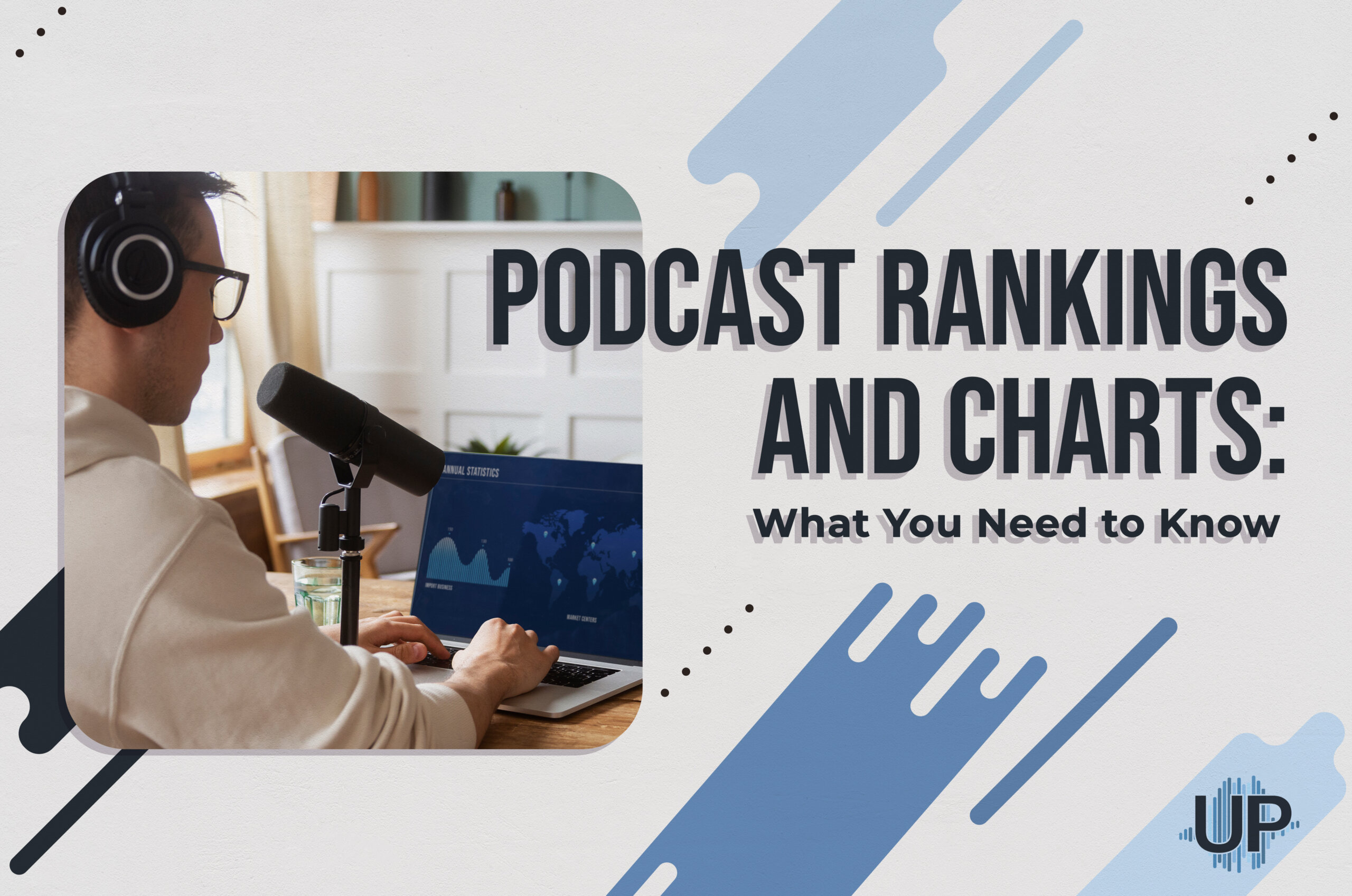
Understanding Podcast Rankings and Charts
Podcasts have seen a meteoric rise in recent years, becoming a powerful medium for content creators, business leaders, and everyday storytellers to connect with a global audience. With over two million active podcasts and more than 48 million episodes in circulation, it’s clear that the podcasting landscape is brimming with opportunities. However, in such a competitive environment, how does a podcast stand out? This is where podcast rankings and charts come into play.
Podcast rankings and charts are essential tools that offer creators a chance to gain visibility, attract new listeners, and measure success against their peers. These charts, often featured on major platforms like Apple Podcasts and Spotify, showcase the most popular and trending shows, helping potential listeners discover content. Whether you're new to podcasting or a seasoned podcaster, understanding how these rankings work is critical for growth.
For more insights on why starting a podcast can benefit your business, check out this article: 8 Reasons to Start a B2B Podcast.
What Are Podcast Rankings and Charts?
Podcast rankings and charts are lists that rank podcasts based on various criteria such as downloads, listener engagement, and reviews. These rankings are typically curated by major platforms like Apple Podcasts, Spotify, and Google Podcasts, each using its own algorithm to measure a podcast's popularity and relevance. Rankings are essential for podcasters because they offer credibility and visibility, serving as a key factor in attracting new listeners. Appearing on these charts can significantly boost a show's exposure, drawing in audiences who rely on these lists to discover new content. For creators, understanding how rankings work and what influences chart placement—whether it's audience retention, episode frequency, or subscriber growth—can be the difference between staying under the radar and gaining widespread recognition.
Why Podcast Rankings Matter
Securing a spot on podcast rankings can be a game-changer for creators, as it opens the door to greater visibility and credibility. Being featured on a chart instantly signals to potential listeners that your podcast is worth checking out, making it easier to attract a broader audience. Additionally, rankings can create a sense of trust and authority, helping to differentiate your podcast in an increasingly crowded market. Higher rankings often lead to more downloads, which in turn can attract sponsors and partnerships, further boosting the growth of your show. For podcasters aiming to grow their listener base and make a lasting impact, understanding and leveraging these rankings is crucial.
Factors Influencing Podcast Rankings
Several key factors play a role in determining where a podcast ranks, and understanding these can help creators make strategic choices to enhance their visibility. Listener engagement, for example, is a major driver; high download numbers, regular listens, and episode completion rates all contribute positively to rankings. Additionally, reviews and ratings on platforms like Apple Podcasts signal to algorithms that a show resonates with its audience, which can lead to a higher placement on the charts. Consistency is another powerful factor—podcasts that release new episodes regularly often see better rankings, as this steady activity shows commitment and keeps listeners returning. Lastly, episode promotion and social media presence can amplify audience reach, attracting new listeners and boosting overall performance. By focusing on these factors, podcasters can work toward achieving a spot on popular charts, helping their show reach new heights.
Listener Engagement
Listener engagement is one of the most powerful factors influencing podcast rankings, as it reflects how invested an audience is in a show. When listeners not only tune in regularly but also stay through entire episodes, it signals to platforms that the podcast is delivering quality content. For instance, a show that encourages listeners to take part in discussions through social media or even share episodes with friends fosters a deeper connection and drives more frequent interactions. Another great example is podcasts that invite audience questions or include listener stories in their episodes, which can enhance the sense of community and keep audiences returning for more. By cultivating strong engagement, podcasters can improve their rankings and build a loyal audience that supports the show’s growth and visibility.
Subscriber Count and Growth
A podcast's subscriber count and the pace at which it grows are crucial elements in boosting its ranking potential. When listeners subscribe, they show a clear commitment to the show, making them more likely to engage with new episodes as soon as they’re released. This kind of loyalty not only drives immediate downloads but also signals to ranking algorithms that the podcast is building a steady, interested audience. Growth in subscriptions, especially when it happens consistently, can further elevate a show’s status, as platforms tend to prioritize shows that are attracting and keeping new listeners. For podcasters, promoting subscriptions—whether through calls-to-action in episodes, special bonuses for subscribers, or collaborations with other shows—can be an effective way to expand their reach and boost their chances of climbing the charts.
Ratings and Reviews
Ratings and reviews are the lifeblood of podcast credibility and a vital component in how rankings are determined. When listeners take the time to leave positive ratings or share thoughtful reviews, it signals to new audiences and platform algorithms alike that the podcast offers value and resonates with its listeners. For example, a glowing review that praises a show’s insightful content or entertaining delivery can encourage someone new to give it a try. Likewise, high ratings build trust, giving a podcast an edge when people are scrolling through countless options. Podcasters can encourage reviews by expressing gratitude to listeners in episodes, sharing standout reviews on social media, or even running small incentives for listeners who leave feedback. By cultivating a steady stream of ratings and reviews, podcasters not only strengthen their relationship with existing listeners but also create a pathway to attracting fresh audiences and improving their overall ranking.
Episode Frequency and Consistency
The frequency and consistency of episode releases play a significant role in podcast rankings, as they keep a show top-of-mind for both listeners and ranking algorithms. Podcasts that release episodes regularly, whether it’s weekly, biweekly, or even daily, establish a reliable rhythm that audiences come to expect and look forward to. Consistent posting not only builds listener loyalty but also signals to platforms that the podcast is active and invested in delivering fresh content. For instance, a podcast that posts new episodes every Tuesday creates a weekly touchpoint that fits seamlessly into a listener’s routine, making it easier for them to stay engaged. Even if life gets busy, planning ahead and maintaining a release schedule can make a real difference, helping podcasters build momentum that supports growth, improves rankings, and ultimately expands the show’s reach.
Social Media Presence and Marketing
An active social media presence and targeted marketing efforts are invaluable for boosting podcast visibility and, ultimately, rankings. When podcasters share episodes, engage with followers, or create discussions around topics from their show, they can effectively reach a broader audience. For example, posting engaging clips or quotes from an episode on platforms like Instagram or LinkedIn can capture attention and encourage new listeners to tune in. Collaborative promotions, like guest appearances on other podcasts or cross-promotions with influencers, further widen the reach. To make the most of your podcast’s social presence, check out these podcast social media community tips to build and engage your audience effectively. A strong social media strategy amplifies your podcast’s reach and fosters a community of loyal listeners eager for the next episode.
Analyzing and Interpreting Podcast Charts
Understanding how to analyze and interpret podcast charts can provide valuable insights that drive growth and improve engagement. These charts reflect not just rankings but trends and patterns that highlight what resonates with audiences. For example, a sudden rise in rankings after a particular episode can indicate that the topic or guest was especially popular, suggesting areas to explore further. Similarly, tracking consistent performance over time helps podcasters understand their audience’s preferences, allowing for more targeted content creation. By viewing podcast charts as tools for learning rather than just benchmarks, creators can refine their strategy, adapt to listener interests, and steadily enhance their show’s impact and reach. Embracing this data-driven approach makes podcasting more dynamic and rewarding, guiding each episode toward greater success.
Types of Podcast Charts
Podcast charts vary in type, each offering insights into different aspects of performance. Overall rankings show top-performing podcasts across all categories, providing high visibility to well-ranked shows. Genre-specific charts, like those for business or true crime, help niche audiences discover relevant content and allow creators to gauge their standing among similar shows. “New and noteworthy” sections spotlight fresh, rising content, drawing attention to unique voices and trending topics. These charts collectively offer a snapshot of a podcast's reach and guide creators in refining their visibility strategies.
Using Chart Data for Growth
Leveraging chart data can be a powerful strategy for podcast growth, offering clues about what resonates with listeners and where there’s room to improve. For example, if a podcast sees a spike in rankings after featuring a specific guest or covering a hot topic, this insight can guide future content decisions, encouraging more episodes in a similar vein. Additionally, understanding which episodes perform best within genre-specific charts can help identify the themes or formats that attract the most engagement from the target audience. Podcasters might also use trends from “new and noteworthy” sections to experiment with timely or trending topics, keeping their content fresh and relevant. By consistently analyzing chart data, creators can make informed choices that foster audience growth, enhance engagement, and boost their show's ranking over time.
Strategies to Improve Podcast Rankings
Improving podcast rankings requires a mix of strategic content planning, audience engagement, and smart promotion. One effective strategy is maintaining a consistent release schedule, as regular episodes keep listeners engaged and signal reliability to ranking algorithms. Encouraging listeners to subscribe, rate, and review the show also boosts visibility, as platforms often prioritize podcasts with strong audience feedback. Promoting episodes on social media or collaborating with other podcasters can extend reach to new audiences and drive additional downloads. Additionally, paying attention to trending topics or popular guests in your niche can help capture audience interest and boost engagement. By combining these tactics, podcasters can work toward higher rankings and build a steady, engaged listener base.
Content Quality
Content quality is foundational to a podcast’s success and a key driver in improving rankings. High-quality content keeps listeners coming back, encourages word-of-mouth promotion, and inspires positive reviews. For example, episodes that are well-researched and offer genuine insights into topics of interest create a lasting impact on audiences. Engaging storytelling, clear audio, and thoughtful editing all contribute to a polished final product that listeners appreciate. Additionally, inviting knowledgeable or entertaining guests can add variety and depth, making episodes more compelling. By focusing on delivering valuable, well-crafted content, podcasters can build loyalty, boost engagement, and ultimately see positive shifts in their rankings.
Engagement Strategies
Effective engagement strategies can significantly elevate a podcast’s connection with its audience and boost rankings. One approach is to invite listeners to participate by submitting questions or topic suggestions, making them feel involved in shaping the content. For example, hosting a Q&A episode where listener questions are answered adds a personal touch and fosters a sense of community. Social media also offers a great platform for engagement—posting episode highlights, polls, or behind-the-scenes content allows for direct interaction with followers and keeps the conversation going between episodes. Running occasional giveaways or incentives for leaving reviews can further encourage audience participation. By actively engaging with listeners, podcasters can strengthen their community, increase loyalty, and drive the kind of active listenership that supports higher rankings.
Marketing and Promotion
A strong marketing and promotion strategy is essential for boosting a podcast’s visibility and attracting new listeners. Sharing engaging snippets from episodes on social media, for instance, can intrigue potential listeners and give them a preview of what they can expect. Collaborating with other podcasters or influencers in similar niches is another effective tactic; guest appearances or cross-promotions can introduce your show to a broader, highly relevant audience. Additionally, featuring highlights or guest quotes in newsletters can capture the interest of subscribers and encourage them to tune in. By implementing a mix of targeted promotion techniques, podcasters can expand their reach, build awareness, and ultimately support higher rankings.
SEO and Metadata Optimization
Optimizing SEO and metadata is a powerful way to improve podcast discoverability and, in turn, rankings. By crafting episode titles, descriptions, and tags with relevant keywords, podcasters make it easier for potential listeners to find their content in search results. For example, a podcast about marketing can use keywords like “digital marketing tips” or “business growth strategies” in descriptions to target audiences looking for these topics. Clear and concise episode titles also help listeners quickly understand the value of each episode, making them more likely to click and listen. Additionally, using metadata fields—such as show notes with timestamped topics and key terms—can improve search visibility across platforms. For more insights on effective SEO strategies, explore these 7 Podcast SEO Strategies. Thoughtful SEO and metadata practices make podcasts more accessible to new listeners, enhancing both reach and ranking potential.
Conclusion
Understanding podcast rankings and charts is a valuable step toward growing a successful show, helping podcasters connect with broader audiences and achieve new levels of recognition. By focusing on quality content, strategic engagement, and smart optimization techniques, any podcast can find its place on the charts and reach listeners who will appreciate and support the show. As you continue to hone your strategy, remember that steady growth and dedicated audience-building are the keys to lasting impact. If you’re ready to take your podcast’s reach even further, explore these B2B Demand Generation Services designed to enhance visibility and drive results. With persistence and the right strategies, your podcast has the potential to thrive and make a meaningful mark in the industry.


